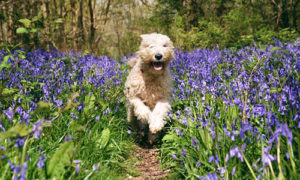
The Canaan Dog, or the Kelev K’naani, shares ancestry with the Pariah dog that existed a thousand years ago and was used as a herding and guard dog by the Israelites. Many of these feral dogs resided in the Negev Desert when the Israelites were displaced, where they lived for hundreds of years. In the 1930s, Dr. Rudolphina Menzel domesticated the breed from his stock of ferals.
The Israeli’s train the breed as military dogs. Also, a breeding program was established to train them as guide dogs. It wasn’t until 1965 that the breed made its first appearance in the United States, with the arrival of four Canaan Dogs, and in 1989, the AKC admitted the breed into its Miscellaneous class. In America, they compete in obedience, agility, and herding trials.

Breed Standard
This dog is medium-sized, moderately built, athletic, and graceful, with square proportions and a bushy tail carried over the back. The breed’s head is wedge-shaped with a tapered muzzle and a slight furrow between the brows. The low-set ears are carried erect, and the eyes are dark and almond-shaped. The breeds expression is watchful and curious.
Breed Facts
| Energy level | Watchdog ability | ||
| Exercise requirements | Protection ability | ||
| Playfulness | Grooming requirements | ||
| Affection level | Cold tolerance | ||
| Friendliness toward dogs | Heat tolerance | ||
| Friendliness toward other pets | Friendliness toward strangers | ||
| Ease of training |
- Popularity: Very rare
- Family group: Livestock, Herding, Primitive
- Country of Origin: Israel
- Date developed: Ancient times
- Original purpose: Sentry, messenger, assistance
- Current function: Herding trials
- Other names: Kalef K’naani, Kelev Cana’ani

Activity level: Moderate. Canaan Dogs do well with two walks daily. Due to a rich working heritage, not many breeds can come close to the Canaan Dog. Therefore, these dogs are not couch potatoes like some breeds. It requires plenty of mental and physical challenges. Although not as active as other herding dogs, the Canaans will be satisfied with long jogs, strenuous playing, and challenging training sessions.
Grooming: A weekly brushing will help maintain the coat.
Coat: The flat, harsh, straight outer coat is ½ to 1½ inches long. The undercoat is soft, straight, flat, short, and of varying density. The coat is longer on the ruff, back of thighs, and tail.
Color: Canaan Dogs come in two color patterns. The first is solid colored, black, or any shade of brown, some with white trim. The second is white with a mask, with or without patches on the body. The mask is the same color as the body patches and covers the eyes and ears, sometimes the entire head.
Group: Herding
Year of recognition by the AKC: 1997
Canaan Dog Temperament

The Canaan Dog is descended from desert pariah dogs, having been developed into a breed around World War II. This breed is molded by natural, rather than artificial, selection, with prominent canine instincts. Canaan Dogs are cautious and alert, with keen senses, and are vigilant about protecting their territory.
The dogs are affectionate and loyal toward their families, but they may become overly protective without proper and consistent socialization. The breed is usually kept with strangers and may not get along with other dogs of the same sex. Canaans are not recommended in homes with small pets. The dog is intelligent, easily trained, and inquisitive. Housetraining is not hard, thanks to their naturally clean habits. Training sessions need to be short and positive.
The Canaan dog not only excels as a herder but also in various tasks that include obedience and dependability. Canaans are docile, tractable, and willing to please. The dogs are natural at guarding, and some bark a lot.
Health
- Major problems: none
- Minor issues: CHD
- Rarely seen: elbow dysplasia
- Recommended tests: hip, elbow, (eye), (knee), (thyroid)
- Life span: 12 to 13 years
- Weight: male – 45 to 55 pounds; female – 35 to 45 pounds
- Height: male – 20 to 24 inches; female – 19 to 23 inches
Breeder and Buyer’s Advice

This breed is scarce. Approximately 15 to 20 litters are born in America each year, and potential buyers may wait up to a year for a puppy. Therefore, you may want to think about an older or rescue dog. However, if you’re willing to wait, you can find breeders with Canaan Dog puppies for sale on the parent club’s website. The price will be contingent on the breeder and the dog’s pedigree.
Parent club: Canaan Dog Club of America; founded in 1965
Rescue: Canaan Dog Rescue Network




